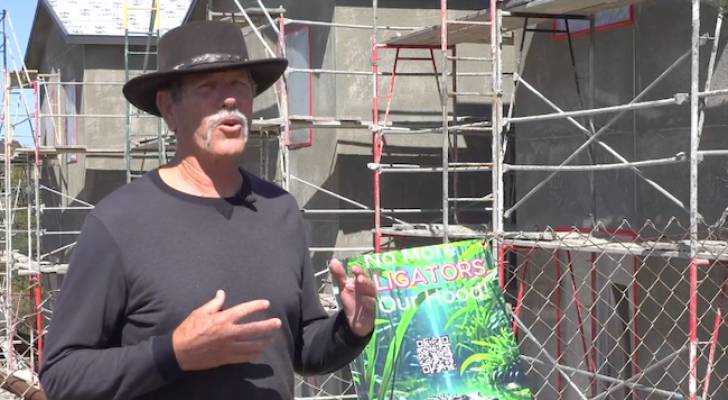
Jim LaMattery, a San Diego residential real estate agent, has been working tirelessly to fight against what he calls “alligator projects.”
The projects are accessory dwelling units (ADU) built by developers, which LaMattery gave the nickname to because of the way alligators “‘pop up’ unexpectedly as they aren’t legally required to give notice to neighbors that they’re coming,” he wrote on his website.
Don’t miss
- I’m 49 years old and have nothing saved for retirement — what should I do? Don’t panic. Here are 5 of the easiest ways you can catch up (and fast)
- Thanks to Jeff Bezos, you can now become a landlord for as little as $100 — and no, you don’t have to deal with tenants or fix freezers. Here’s how
- Gain potential quarterly income through this $1B private real estate fund — even if you’re not a millionaire. Here’s how to get started with as little as $10
One recent project on Almayo Avenue in the Clairemont neighborhood will house 17 ADUs in the backyard of a single-family home. LaMattery told CBS 8 reporters that each 441-square-foot unit will have one bedroom, one bath and will be rented for $2,600 per month.
“They’re over-built, bloated monstrosities in the middle of our neighborhoods," LaMattery said.
On his website, he argues that these projects — thanks to the Complete Communities Program— will lead to negative repercussions, like placing an unnecessary overload on resources and increasing the cost of housing for other residents.
"My greatest joy in real estate was selling to young people a new home. That, to me, is what the American dream is. This ain’t no American dream," LaMattery told CBS 8. "This is an American nightmare."
A breakdown of the Complete Communities program
The Complete Communities Housing Solutions program in San Diego was developed to help address the housing shortage and lack of affordable housing in the city.
The goal is to meet the city’s Regional Housing Needs Assessment (RHNA) by increasing the number of housing units within the next eight years.
Some of the strategies the program proposes include implementing affordable multi-family housing in areas near transit and for developers to invest in amenities in neighborhoods, like parks and plazas.
However, residents don’t have a say in any of these developer-led projects, as the program allows for “streamlined processing” and doesn’t require any public input or notice, according to CBS 8. This is a cause for concern for LaMattery and other homeowners.
Read more: Want an extra $1,300,000 when you retire? Dave Ramsey says this 7-step plan ‘works every single time’ to kill debt, get rich in America — and that ‘anyone’ can do it
What’s the big deal with ADUs?
ADUs in general aren’t the problem for those against the alligator projects. Rather, it’s the fact that developers can come in and build them without addressing any potential concerns from others living in the area.
Bill Buchwald, a resident of the Clairemont neighborhood, told CBS 8 reporters he was surprised when one of these development projects popped up. He’s concerned about there being less access for emergency vehicles, more power lines overhead and overcrowding.
"If you get high winds and they arc against the building, everything’s going to go up,” he said, referring to the power lines.
Others, like John Schwartz, told reporters he was worried about more projects in the pipeline, saying that “it’s an exploitation of neighborhoods that shouldn’t be happening.”
While these concerns are real, there are some potential benefits to increasing the amount of ADUs.
For one, it can increase much needed housing supply at a more affordable price for those who may find available options too cost prohibitive.
Since the Complete Communities Housing Solutions program is prioritizing areas with close access to public transit, it could help people without cars find somewhere to live that allows them to travel throughout the city easily.
Still, efforts are in place to repeal the program.
What’s being done to repeal the program
According to Fox 5, the San Diego City Council voted in March to start scaling back the program to prevent developers from taking advantage of neighborhoods. The council is currently reassessing its rules before updating the program.
LaMattery currently has a ballot initiative survey to collect the opinions of those who would like to repeal the program, too. He hopes to get 144,000 responses by the end of this summer.
He is also encouraging San Diego residents to join his “alligator tour” to see the types of ADUs being built and file a complaint with city officials before the assessment period is over.
Other states with similar laws
Over the past several years, states throughout the country have implemented similar plans to address the housing shortage and to create more affordable housing.
For instance, Oregon banned zoning designed only to house single-family homes. A law signed in 2019 requires cities with a population of over 1,000 to let duplexes be built, whereas areas with over 25,000 residents need to allow triplexes, four-unit homes and townhomes.
And in Massachusetts, the MBTA Communities law allows multifamily housing to be built close to transit stations.
How homeowners can fight back
Your best bet is to be aware of what is happening in your community and voice your concerns.
Start by looking up any housing-related news in your local area and what types of housing is allowed there. Consider completing a public records request for any properties you’re concerned about and contact your city council representative.
Attending or staying up to date on city council meetings will give you the opportunity to be more informed of upcoming laws or housing projects before they happen.
What to read next
- Don’t have the cash to pay Uncle Sam in 2025? You may already be eligible for a ‘streamlined’ handshake with the IRS — here’s how it works and how it can potentially save you thousands
- Here are 5 ‘must have’ items that Americans (almost) always overpay for — and very quickly regret. How many are hurting you?
- Robert Kiyosaki warns of a ‘Greater Depression’ coming to the US — with millions of Americans going poor. But he says these 2 ‘easy-money’ assets will bring in great wealth. How to get in now
This article provides information only and should not be construed as advice. It is provided without warranty of any kind.


